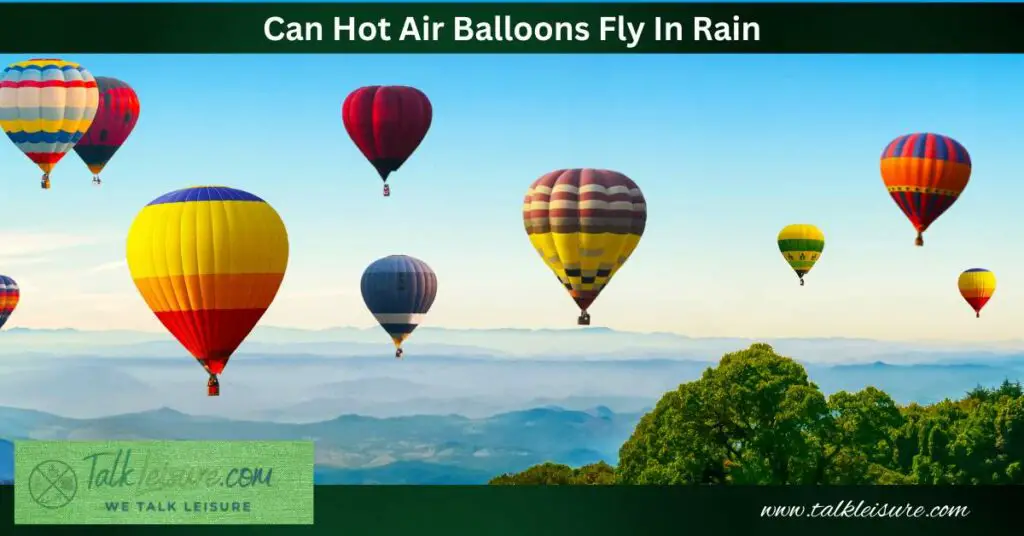Have you ever gazed at the sky, admiring the mesmerizing beauty of hot air balloons gracefully floating in the air, and wondered what happens when the weather isn’t so cooperative?
Picture this: it’s a lovely morning, and you’ve been eagerly waiting to cross off that bucket list experience of a hot air balloon ride.
Just as you reach for the sky, the rain decides to make its grand entrance, leaving you puzzled about the fate of your adventurous escapade.
Can hot air balloons still fly amidst the showers?
In this blog post, we’ll unravel the mysteries surrounding hot air balloons and their ability (or inability) to soar through the rainy weather.
So, the next time you find yourself daydreaming about those magical balloons, you’ll be armed with plenty of knowledge to impress your fellow enthusiasts and evade cloudy misconceptions.
A common question among those considering hot air balloon rides is whether these majestic crafts can fly in the rain.
While it might seem interesting, it is important to understand that hot air balloons and rain do not mix well for various reasons.
The impact of rain on the balloon’s performance and passengers’ safety takes precedence over the desire to experience an adventurous balloon ride amidst falling raindrops.
As exciting as it may sound, embarking on a hot air balloon journey in the rain can lead to potentially dangerous and uncomfortable situations for the pilot and passengers.
This article will explore why hot air balloons should not fly during rainfall, prioritizing safety and comfort and ensuring a pleasurable experience for all involved.
How Hot Air Balloons Work
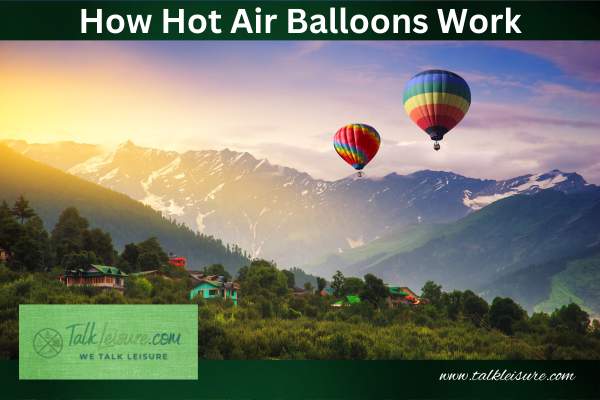
Hot air balloons are a fascinating and thrilling way to experience the beauty of the skies.
The air inside the balloon is heated using burners fueled by propane gas, and as the temperature increases, the air molecules expand and become less dense than the surrounding air, making the balloon rise.
On average, hot air balloons fly 3 to 6 miles per hour whereas, a helicopter covers about 75 to 100 miles in 30 minutes.
Pilots rely on detailed aviation weather forecasts to determine whether a flight will be safe and comfortable for passengers.
However, a private pilot license posses certain restriction and limitation when flying around the world.
This is simple and enables you to share the joys of hot air ballooning with loved ones.
They prioritize the safety and wellbeing of their passengers, often rescheduling flights for when the weather is more favorable.
A hot air balloon flight is a unique experience combining adventure and tranquility, but ensuring a safe environment for all involved is crucial.
Generally, no food, drink, or supplements is allowed when flying in a hot air balloon. This is because the flight is too short.
In contrast during a flight journey, you are allowed to take supplements like creatine, and other food items.
Can Hot Air Balloons Fly In The Rain?
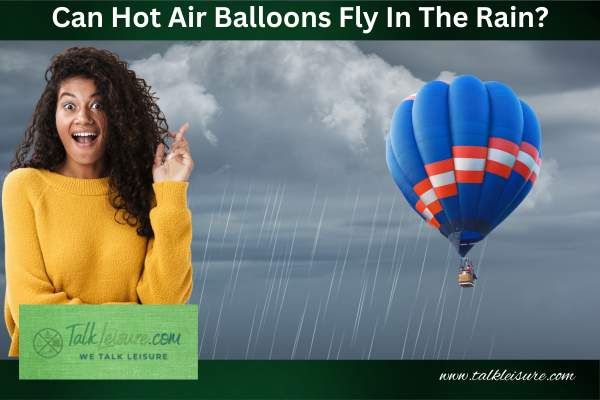
Several factors determine the safety and feasibility of hot-air balloon flights, one of which is rain. For several reasons, it is unsafe for hot air balloons to fly in rainy weather.
Firstly, the top of the balloon reaches temperatures close to the boiling point of water, and when rain falls on the fabric, it cools the air inside the balloon.
This leads to a rapid descent, and the pilot has to supply extra heat from the burners to compensate for the heat loss.
Excessive use of the burner can damage the balloon fabric and exhaust the limited propane gas supply, making it even more difficult to control the balloon’s movement.
Besides the temperature, rain adds weight to the balloon, causing a faster descent. Furthermore, rainwater tends to run down the sides of the balloon, dripping into the basket and on the passengers, causing an uncomfortable and unsafe experience.
Why Hot Air Balloon Flights Get Cancelled In Fair Weather
Hot air balloons require optimal weather conditions to ensure a safe and enjoyable flight.
One of the primary reasons for cancellation in fair weather is the presence of rain.
Rainfall can have several adverse effects on a hot air balloon during its flight.
Hot air balloon pilots rely on detailed aviation weather forecasts that provide precise information on wind speed and local conditions.
If heavy rainfall is likely, even if it is not currently raining, pilots may decide to cancel a flight, keeping the passengers’ safety and comfort in mind.
What Happens If It Starts Raining When You Are Flying On A Hot Air Balloon?
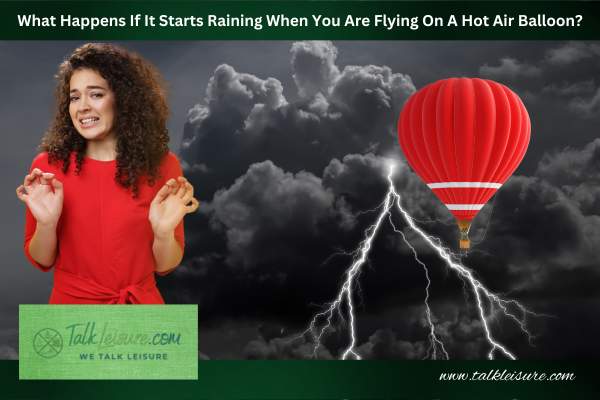
Hot air ballooning can be a thrilling and serene experience for many, but weather conditions significantly ensure a safe and enjoyable flight.
You can take a camera to capture the beautiful experience.
Also, take a hat and wear comfortable clothes during the ride.
However, it is your responsibility to take care of your belongings.
Closed toe shoes or boots are best recommend for hot air balloon rides. You may also steel-toed shoes when flying on a plane or hot air balloon.
So what happens if it starts raining while you’re in the air?
In such a situation, the pilot must act swiftly to ensure the safety of the passengers.
The pilot must be skilled in handling these challenges, possibly allowing a safe landing to avoid potential risks associated with flying in the rain.
Pilots avoid flying if rain is forecasted, prioritizing a comfortable and secure flight for all.
What Weather Conditions Prevent Hot Air Ballooning?
Weather conditions play a significant role in determining whether hot air ballooning can take place.
Following are a few weather conditions that prevent hot air ballooning:
1. Wind speed And Direction
Wind speed and direction greatly affect hot air balloons, with ideal flying conditions being light and stable winds between 4-6 miles per hour.
If the wind speed exceeds this range, it can become difficult to control the flight, leading to safety concerns for the passengers and the pilot.
Maximum safe wind speeds for hot air balloons are generally around 8–10 mph.
When the winds are too strong, inflating the balloon becomes difficult as the balloon fabric acts like a giant sail, making it nearly impossible to fill with cold air from the fan.
Strong winds can also cause the balloon to drift too far off course, potentially leading it into unsuitable landing areas such as densely populated regions, forests, restricted airspace, or large bodies of water.
In addition to surface winds, pilots must also consider the winds aloft, which are the winds at higher altitudes ranging from 1 to 9,000 feet.
Balloons may not reach these heights, but the winds aloft can still impact the flight and dictate whether it is safe to fly or not.
Balloon flights can be canceled if the aloft winds exceed 18–20 knots or 20 miles per hour.
Ultimately, the safety of the passengers and pilot is the top priority, which is why hot air balloons only fly in favorable weather conditions with suitable wind speeds and directions.
2. Temperature And Humidity
Temperature and humidity play crucial roles in hot air ballooning, as they can significantly impact the balloon’s performance and passengers’ comfort.
In ideal conditions, hot air balloons operate best when the temperature is cooler, as the temperature difference between the inside and outside of the balloon envelope generates the required lift.
While balloons can fly in colder weather, they may face challenges if the liquid propane in the fuel tanks becomes too cold to function correctly.
When it comes to humidity, higher levels can cause fog, mist, or low clouds, adversely affecting pilots’ visibility.
Ideally, balloonists need visibility of at least 1 to 3 miles to operate safely.
Although visibility can be challenging to predict, the best times for hot air ballooning are typically just after sunrise and 2-3 hours before sunset, when winds are lighter at 4-6 mph, and weather conditions tend to be more stable.
3. Rain and precipitation
Hot air balloons provide a serene and mesmerizing experience, gliding through the sky gracefully.
However, one commonly asked question is whether these balloons can operate in rainy conditions.
While it is technically possible to fly a hot air balloon in the rain, it is generally not considered safe for various reasons.
Wet conditions make it more challenging to control the hot air balloon, even during light rain, and can severely impact the flight experience.
As a result, hot air balloon pilots must prioritize passenger safety and adhere to weather guidelines.
What Is The Perfect Weather Condition For Hot Air Ballooning?
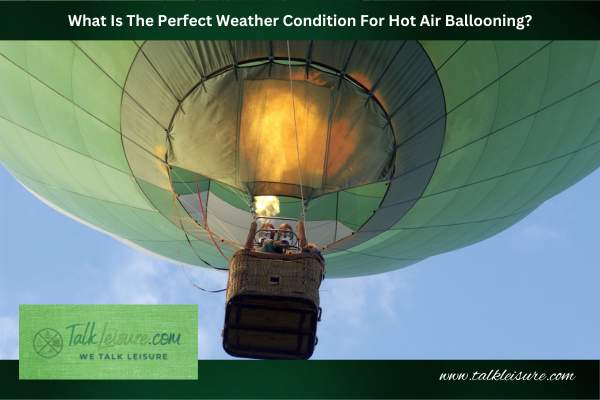
The perfect weather conditions for hot air ballooning involve clear skies, good visibility, and light winds.
Ideally, the winds should be less than 10 miles per hour, allowing the balloon to navigate smoothly and safely.
These conditions help ensure a safe journey and provide passengers with a comfortable and enjoyable experience.
Rainy weather, on the other hand, is not suitable for hot air ballooning.
In conclusion, the perfect weather for hot air ballooning is characterized by clear skies, good visibility, and light winds.
This ensures a safe and enjoyable flight for passengers, avoiding the risks associated with rainy and unfavorable weather conditions.
However, if you are just after surgeries it is better to avoid hot air balloon rides since it may impact the recovery process.
In contrast, it is best to avoid adventures with hot air balloon rides until you are recovered because high-altitude sickness makes blood vessels more vulnerable to leaks.
It is also recommended to avoid hot air balloon rides soon after cataract surgery. However you can fly in planes 5 to 7 days after cataract surgery.
What Are The Challenges Faced By Hot Air Balloons In Rain?
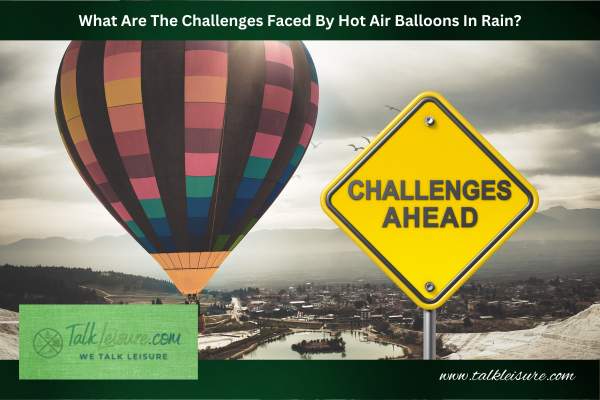
Hot air balloons have long captured people’s imaginations with their serene and captivating flights.
However, a common question is whether they can fly in the rain.
This combination of reduced visibility and the potential weight increase caused by rain-soaked fabric makes flying in the rain challenging and potentially unsafe.
As a result, hot-air balloon pilots tend to prioritize safety and often postpone or cancel flights when rain is anticipated.
1. Effect Of Rain On The Balloon Fabric
Rain significantly affects the fabric of a hot air balloon and can create several challenges for safe flight.
One of the primary concerns is that raindrops cool the balloon’s envelope upon contact.
The top of the balloon can reach temperatures of 100 degrees Celsius, but rain can bring that temperature down quickly.
To compensate for this heat loss, a pilot must use more burner propane to maintain altitude.
Excessive use of propane can damage the balloon fabric, making it difficult to control the flight.
Furthermore, rain adds weight to the balloon, making it heavier and requiring even more heat to keep it in the air.
This accumulated water can eventually run down the sides of the envelope, dripping into the basket and onto the passengers.
The combination of a damp, weakened fabric and the additional heat needed to counteract the effects of rain creates a precarious situation for those aboard.
2. Reduced Visibility And Safety Concerns
Reduced visibility and safety concerns are significant challenges hot air balloons face when flying in the rain.
Due to decreased visibility, rainfall can greatly impact a pilot’s ability to navigate and maintain situational awareness.
This can be particularly dangerous when trying to avoid obstacles or other aircraft in the sky.
3. Potential For Weight Gain Due To Water Absorption
One of the challenges hot air balloons face during rain is the potential weight gain due to water absorption.
When a balloon is exposed to rain, the fabric of its envelope tends to absorb water.
This subsequently increases the overall weight of the balloon and can significantly affect its flight performance.
As the balloon becomes heavier, more heat is required to keep it in the air, putting extra strain on the propane gas supply.
To compensate for this weight gain, the pilot may have to use the burners more frequently, which can lead to a rapid depletion of the available propane gas.
4. Risk Of Lightning During Thunderstorms
One of the primary concerns when flying hot air balloons in rainy conditions is the risk of encountering lightning during thunderstorms.
Being in a hot air balloon during a thunderstorm can seriously threaten the passengers and the pilot.
Lightning can strike the balloon, causing severe damage and even leading to a crash.
Additionally, thunderstorms bring unpredictable winds that make it difficult for the pilot to control the balloon’s trajectory.
Final Thoughts
In conclusion, flying hot air balloons in the rain is not a safe or practical option.
Several reasons for this stem from the fundamental aspects of the weather conditions and the design and functioning of a hot air balloon.
The interaction between the rain and the balloon’s envelope can weaken the fabric, increasing the risk of potential damage or even accidents during the flight.
This, coupled with decreased visibility and potentially unpredictable wind patterns, makes hot air balloons more difficult to maneuver and less safe in rainy conditions.
Furthermore, flying in the rain can be less enjoyable for passengers, who will likely get wet and muddy as the water drips down the envelope and into the basket.
Balloon companies also incur extra costs due to increased fuel consumption and potential damage to the balloon itself.
In summary, while floating amidst falling raindrops might seem like a serene and peaceful experience, hot air ballooning in the rain is impractical, unsafe, and unwise.
Check our recent blog on “Can Felons Fly Planes?” to learn about the rules and regulations to become a pilot even with a felony conviction.
FAQS
Why Don’t Hot Air Balloons Fly During The Day?
There are a few reasons why hot air balloon flights are usually scheduled for early mornings and late afternoons.
One of the primary reasons for avoiding daytime flights is the stability of the air.
As the sun heats the earth’s surface during the day, it causes the air to become unstable, resulting in turbulent air currents. The factors make it challenging to control the hot air balloon.
In contrast, the air is more stable during the early morning and late afternoon hours, allowing smoother and safer flights.
Another factor that affects hot air balloon flights is thermal activity.
Thermals are columns of rising warm air that form when the sun heats the ground.
Early and late afternoons typically have reduced thermal activity, making it a more suitable time for hot air balloon flights.
Lastly, the temperature difference between the inside and outside air affects the balloon’s buoyancy.
During daytime hours, the temperature difference is generally smaller, making it harder for the balloon to rise and stay afloat.
Can Hot Air Balloons Fly At Night?
Hot air balloons can technically fly at night. In contrast, it is not generally recommended and is often restricted by aviation regulations.
Visibility is limited at night, making it harder for pilots to navigate and judge distances.
The lack of natural light means ground crews might struggle to follow the balloon’s path and identify suitable landing sites.
Changes in atmospheric conditions play a significant role. As temperatures drop at night, the air becomes denser, affecting the balloon’s buoyancy and handling.
Nighttime weather can be unpredictable, with the possibility of sudden changes in wind direction, speed and even the development of unexpected fog or storms.
It is crucial to consider local aviation regulations, which often restrict hot air balloon flights during nighttime hours due to safety concerns.
What Is The Speed Of Hot Air Balloons?
A common question regarding hot air balloon flights is their speed during operation.
Hot air balloons typically travel at the same speed as the wind they are flying in. This is because they maintain a stable connection with surrounding air currents.
On average, hot air balloons fly between 3 to 6 miles per hour (5 to 10 kilometers per hour) for a safe and enjoyable experience.
The flight speed of a hot air balloon depends on several factors, including the altitude, surrounding wind conditions, and the pilot’s control of the burners.

